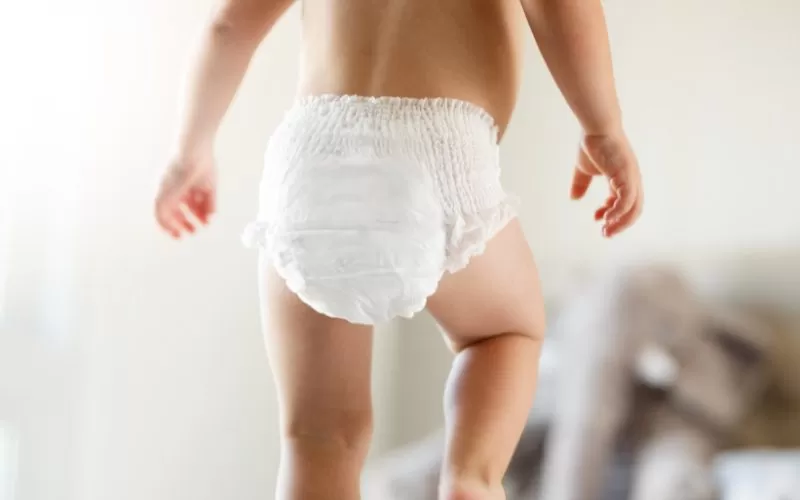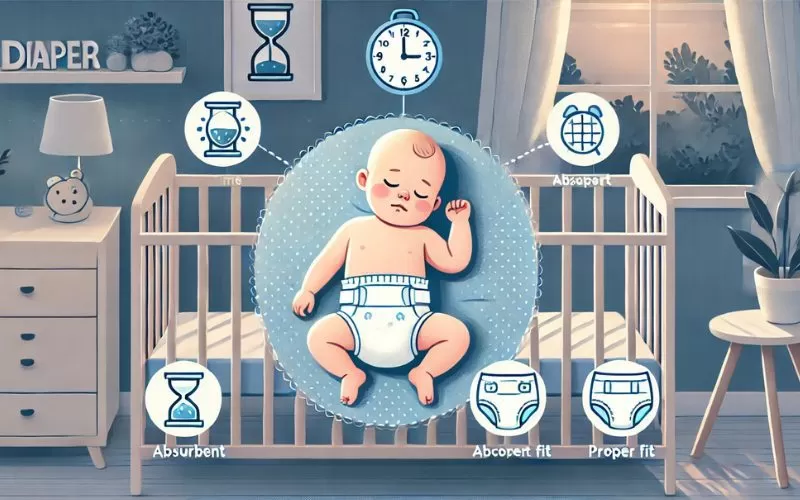Table of Contents
Stop Overnight Diaper Leaks
Every parent knows the frustration of waking up to a soaked crib sheet or pajamas. Nighttime diaper leaks are not only inconvenient but can also disrupt your baby’s sleep, leading to fussiness and poor rest for everyone. Understanding how to manage and stop overnight diaper leaks is key to ensuring that your baby stays dry throughout the night. In this guide, we’ll provide expert insights on preventing these leaks, recommend products, and discuss how to stop overnight diaper leaks for good. These tips will help both you and your baby sleep peacefully.
For more detailed guidance on preventing diaper leaks and ensuring proper diapering practices, visit the CDC’s Safe and Healthy Diaper Changing Steps. Following these expert recommendations can help maintain your baby’s comfort and hygiene, ultimately reducing the likelihood of leaks overnight.
Dealing with Diaper Leaks and How to Prevent Them

Diaper leaks happen due to various reasons such as improper fit, over-saturation, or incorrect diaper positioning. The first step in addressing diaper leaks is understanding why they occur and how to deal with them efficiently.
How to Deal With Sleep Deprivation After Baby: Sleep deprivation is one of the most challenging aspects of new parenthood, especially when you’re also dealing with frequent diaper leaks at night. Finding ways to maximize your rest can make all the difference. Start by ensuring that your baby’s diaper is properly secured and using overnight diapers designed to handle long stretches. You can also read our full guide on How to Deal With Sleep Deprivation After Baby for tips on catching up on rest, establishing a sleep routine, and managing exhaustion during the early months of parenthood.
1. Ensure Proper Diaper Fit

The right diaper size plays a crucial role in preventing leaks. A diaper that’s too loose will leave gaps around the legs or waist, causing leaks, while a diaper that’s too tight might lead to discomfort or cause the diaper to bunch up, leading to inefficiency in absorption.
- Sizing Matters: It’s essential to choose the right size based on your baby’s weight. Sizes differ among brands, so make sure to follow the brand’s size guide to avoid any mismatch.
- Check the Leg Cuffs: Leg cuffs are designed to stop leaks, but if they’re tucked inwards or aren’t snug around the legs, leaks can occur. After putting the diaper on, run a finger around the leg openings to ensure the cuffs are pulled out and fitted properly.
- Watch for Growth Spurts: Babies grow fast, and their diaper size needs to grow with them. If you start noticing frequent leaks, it may be time to size up the diaper.
Ensuring the diaper fits snugly but isn’t too tight is one of the most important ways to prevent leaks.
Managing Diaper Blowouts and Leaks
Dealing with diaper blowouts and leaks can be challenging for parents, especially during the night when messes can disrupt sleep. To minimize leaks, ensure you’re using the right size diaper for your baby’s weight, as an ill-fitting diaper can lead to gaps where leaks occur. Another helpful tip is to invest in overnight diapers, which are designed to offer extra absorbency and protection. Consider using diaper covers for added protection, which can help contain potential blowouts. Additionally, using high-quality wipes ensures a thorough clean-up without irritating your baby’s skin. Check out our selection of overnight diapers, diaper covers, and sensitive baby wipes to make managing leaks easier and keep your baby comfortable throughout the night.
2. Choose the Right Type of Diaper for Overnight Use

Regular daytime diapers are not designed to handle the long hours of sleep that nighttime demands. Overnight diapers offer extra absorbency and are specifically created to provide long-lasting protection.
- Overnight Diapers: These diapers are made with extra layers of absorbent material that can hold more liquid for up to 12 hours of protection.
- Absorbent Gel: Look for diapers with absorbent gel technology. This material helps pull moisture away from your baby’s skin, keeping them drier for longer.
Pro Tip: You can also use regular diapers during the day and save overnight diapers for nighttime to extend their use.
3. Double Diapering: A Tried and True Method
For heavy wetters, even the most absorbent diapers may not be enough. Double diapering involves putting two diapers on your baby—one on top of the other—to increase absorbency and prevent leaks.
- Layering Up: Put a regular diaper on your baby first, followed by a larger size overnight diaper on top. This method provides double the absorption power without compromising comfort.
- Booster Pads: Instead of using two diapers, you can try inserting a booster pad inside the diaper. These pads are designed to increase the capacity of the diaper, making them ideal for heavy wetters or longer nighttime stretches.
4. Check the Diaper Regularly

Monitoring your baby’s diaper at night can help prevent over-saturation. If your baby tends to wake up during the night, use that opportunity to check or change the diaper before it becomes too full. This practice can drastically reduce leaks and ensure your baby stays comfortable throughout the night.
Tip: Keep nighttime diaper changes as quiet and dim as possible to avoid waking your baby fully.
While preventing overnight diaper leaks is crucial for your baby’s comfort and avoiding skin irritation, it’s equally important to stay informed about other common health concerns in newborns, such as jaundice. Jaundice in Newborns – Symptoms, Causes, and Treatment is a condition that can affect many babies during the first few days of life. Understanding the symptoms and knowing how to manage them can help ensure your baby stays healthy and comfortable.
Managing Nighttime Diaper Leaks
Managing nighttime leaks often requires adjusting routines and incorporating some additional steps into your nightly preparation. Once you understand the problem, you can put simple yet effective strategies in place.
1. Pre-Bedtime Fluid Management
Managing your baby’s fluid intake before bedtime is one of the most straightforward ways to reduce nighttime diaper leaks.
- Limit Fluids Before Bed: While hydration is essential for your baby, reducing the amount of fluid they consume in the hour leading up to bedtime can significantly reduce the volume of urine produced overnight. Adjust your baby’s feeding schedule so that the bulk of their feeding happens earlier in the evening.
- Timed Feeding: Aim to give the last bottle or breastfeeding session about 30 minutes to an hour before putting your baby to bed. This allows enough time for digestion and the opportunity to change their diaper before they fall asleep.
2. Establish a Routine for Nighttime Diaper Changes

Setting a consistent pre-bedtime routine is essential for keeping your baby dry at night. This routine should include the following steps:
- Fresh Diaper Right Before Bed: Make sure to change your baby’s diaper just before putting them down to sleep. Even if the diaper seems clean, starting the night with a fresh, dry diaper ensures the longest protection possible.
- Barrier Cream: Consider applying a diaper cream or barrier ointment to your baby’s skin before putting on their nighttime diaper. This helps to protect against diaper rash that can result from extended exposure to moisture.
3. Dress Your Baby in the Right Pajamas
Loose or improperly fitting pajamas can cause the diaper to shift, leading to gaps around the legs or waist. Opt for snug-fitting pajamas that help keep the diaper in place, reducing the likelihood of leaks.
- Choose One-Piece Pajamas: Pajamas that cover the whole body, like footed sleepers or sleep sacks, can help keep everything in place throughout the night.
- Avoid Tight Waistbands: Tight waistbands can compress the diaper, reducing its ability to absorb efficiently. Choose pajamas that are snug but not too tight.
How To Stop Overnight Diaper Leaks For Good

Now that you’ve incorporated some basic prevention techniques, it’s time to look at more advanced methods that will help stop overnight diaper leaks for good. Here are some strategies that have worked for parents over the years.
1. Waterproof Diaper Covers
For added protection, consider using waterproof diaper covers. These covers provide an additional layer of defense, especially for heavy wetters, and can contain any potential leaks that escape from the diaper.
- Reusable Covers: Many waterproof covers are reusable, making them an eco-friendly choice. They’re also easy to wash and dry, so you can have them ready for use every night.
- Full Coverage: Make sure the cover fully covers the diaper, particularly around the legs and waist, where leaks are most likely to occur.
2. Use a Mattress Protector
Even with the best strategies in place, occasional leaks can still happen. Protect your baby’s mattress by using a waterproof mattress protector. These protectors can absorb any leaks and keep the mattress clean and dry, making cleanup much easier.
- Easy to Wash: Look for mattress protectors that are machine washable. This will make your life much easier when leaks do occur, as you can quickly toss them into the laundry.
- Breathable Materials: Opt for a protector that is waterproof but also breathable to ensure your baby stays comfortable throughout the night.
How to travel with a baby, and the gear you need: Traveling with a baby requires careful planning to ensure comfort and convenience for both you and your little one. Essentials like a sturdy travel stroller, a spacious diaper bag, and portable baby wipes are non-negotiable. You’ll also want to pack a travel crib for overnight stays and a baby carrier for hands-free mobility. To keep your baby dry and prevent leaks while traveling, don’t forget to stock up on overnight diapers, like [Brand Name Diapers] that are designed for extra absorbency. Additionally, invest in a waterproof diaper changing pad, like the [Brand Name Changing Pad], to make diaper changes easy and mess-free, no matter where you are.
Additional Tips to Keep in Mind
- Positioning Your Baby: Some parents find that changing their baby’s sleep position can reduce diaper leaks. If your baby tends to sleep on their stomach, try shifting them slightly to their side or back to prevent the front of the diaper from becoming overloaded.
- Monitor Wetting Patterns: Track when your baby tends to wet the most, and adjust your routine accordingly. Some babies may have heavier wetting periods during certain hours of the night, and knowing when this happens can help you manage it more effectively.
- Keep an Emergency Kit Nearby: Prepare an easy-access diaper changing kit near the crib. This should include a fresh diaper, wipes, and a change of pajamas. Having everything within reach will make middle-of-the-night diaper changes quicker and less disruptive for both you and your baby.
Conclusion
By following these expert tips and making small adjustments to your routine, you can effectively manage nighttime diaper leaks and keep your baby dry and comfortable. From ensuring the right fit to using advanced products like overnight diapers, booster pads, and waterproof covers, you’ll find that preventing leaks becomes much easier over time.
No parent wants to deal with middle-of-the-night diaper leaks, but with a few smart strategies, you can stop overnight diaper leaks for good and enjoy a peaceful night’s sleep.

